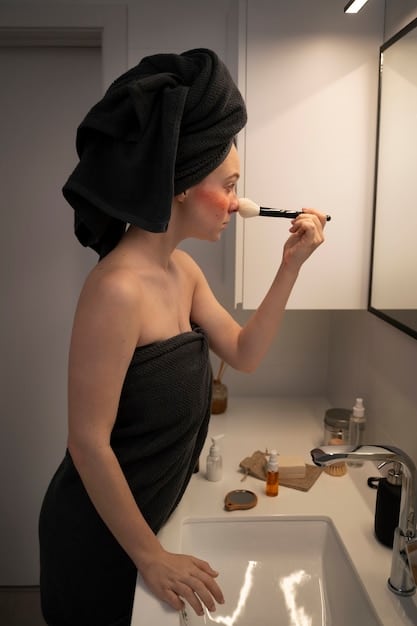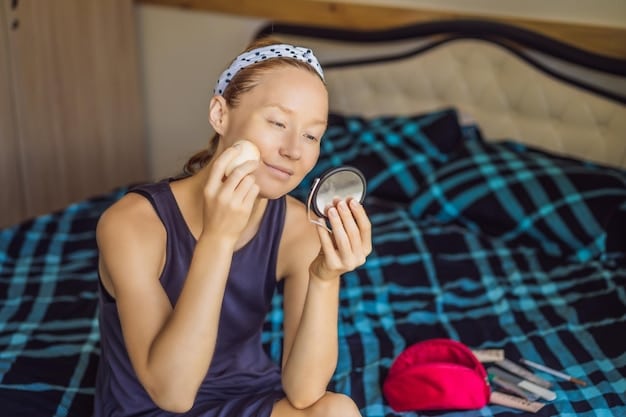Nighttime Skincare Routine: 5 Steps to Repair & Rejuvenate

A nighttime skincare routine is essential for repairing and rejuvenating your skin while you sleep, focusing on cleansing, treating, moisturizing, and using targeted products to address specific concerns like aging or acne, resulting in a healthier, more radiant complexion.
Your skin works hard all day, battling pollution, sun exposure, and makeup. A dedicated nighttime skincare routine: 5 essential steps for repairing and rejuvenating your skin while you sleep is crucial for allowing your skin to recover and thrive.
The Importance of a Nighttime Skincare Routine
During the day, your skin is in protection mode, fending off environmental aggressors. At night, while you sleep, your skin switches to repair mode. This is when it regenerates cells and recovers from the day’s damage. Therefore, a consistent nighttime routine is not just a luxury; it’s a necessity for healthy, radiant skin.
Why Nighttime is Prime Time for Skincare
Cell turnover is more active at night and certain ingredients are more effective when applied before bed. Using the right products can maximize these processes, offering benefits that daytime routines simply can’t match.
- Maximize Cell Turnover: Nighttime is when your skin’s natural regeneration process is at its peak, making it the ideal time to use products that promote cell turnover.
- Targeted Treatments: Ingredients like retinol and certain acids, which can increase sun sensitivity, are best used at night.
- Enhanced Absorption: Without the need to defend against environmental factors like UV rays and pollution, skincare products can penetrate more deeply into the skin overnight.
Incorporating a targeted nighttime skincare routine can lead to visible improvements in skin texture, tone, and overall health, making the most of your skin’s natural repair cycle.

Step 1: Thorough Cleansing is Crucial
The first and most foundational step of any nighttime skincare routine is cleansing. It washes away the day’s grime, makeup, and pollutants so that your other skincare products can penetrate effectively.
Why Cleansing at Night is Non-Negotiable
Skipping this step can lead to clogged pores, breakouts, and dull skin. Think of your skin as a canvas; you need to start with a clean surface to create a masterpiece. Cleansing is that clean slate.
- Removes Makeup: Makeup left on overnight can clog pores and lead to acne breakouts.
- Eliminates Pollutants: Environmental pollutants accumulate on the skin during the day and can cause damage if left unaddressed.
- Prepares Skin: Cleansing ensures that your skin is ready to absorb the beneficial ingredients from subsequent products.
Choose a cleanser appropriate for your skin type. Oil-based cleansers can melt away makeup effectively, while gel cleansers work well for oily or acne-prone skin. Milk or cream cleansers are gentle options for dry or sensitive skin.
Step 2: Exfoliate for Enhanced Renewal
Exfoliation helps to remove dead skin cells, revealing a brighter and smoother complexion. It’s a key step in promoting healthy skin turnover.
Select a gentle exfoliant that suits your skin type. Over-exfoliating can cause irritation and compromise your skin’s barrier. Less is sometimes more with exfoliation.
Types of Exfoliants to Consider
There are physical and chemical exfoliants, each with its own set of benefits. Physical exfoliants manually scrub away dead skin cells, while chemical exfoliants use acids to dissolve them.
- Physical Exfoliants: These include scrubs with small grains or brushes. Be gentle; avoid harsh scrubbing.
- Chemical Exfoliants: AHAs (alpha-hydroxy acids) like glycolic acid and lactic acid are popular for their exfoliating and hydrating properties. BHAs (beta-hydroxy acids) like salicylic acid are ideal for oily and acne-prone skin.
Exfoliating once or twice a week is usually sufficient. Watch your skin for signs of irritation and adjust the frequency as needed to maintain a healthy glow.
Step 3: Treat with Serums and Actives
Serums are concentrated treatments designed to target specific skin concerns. They contain active ingredients that penetrate deeply into the skin for maximum effectiveness. This is also where you incorporate any prescribed or recommended actives.
Choosing the Right Serums
What are your key skin concerns? Fine lines? Dark spots? Acne? Choose serums that address your specific needs. Common serum ingredients include retinol, vitamin C, hyaluronic acid, and peptides.
- Retinol: A powerhouse ingredient for anti-aging. It boosts collagen production and accelerates cell turnover.
- Vitamin C: An antioxidant that brightens the skin and protects against environmental damage.
- Hyaluronic Acid: A humectant that draws moisture into the skin, plumping and hydrating it.
Apply serums after cleansing and exfoliating, but before moisturizing. Allow the serum to fully absorb into your skin before moving on to the next step.
Step 4: Moisturize to Hydrate and Repair
Moisturizing is critical for keeping your skin hydrated and supporting its natural barrier function. It seals in the serums and treatments you’ve applied, maximizing their effectiveness.
Selecting the Ideal Night Cream
Look for a night cream that’s richer and more emollient than your daytime moisturizer. Ingredients like ceramides, shea butter, and hyaluronic acid can help to nourish and repair the skin overnight.
Different skin types will benefit from different formulations. Lightweight lotions may suffice for oily skin, while dry skin may require a thicker cream or balm.
- Ceramides: Help to restore the skin’s natural barrier function.
- Shea Butter: A rich emollient that deeply moisturizes and soothes the skin.
- Hyaluronic Acid: Provides intense hydration for plump, supple skin.
To apply, gently massage the cream into your face and neck using upward strokes. This aids absorption and can stimulate circulation in the process.

Step 5: Targeted Treatments for Specific Concerns
This step is all about addressing any individual skin issues you might have, from acne to dark spots to aging. Here, you’d incorporate targeted treatments designed to tackle these specific concerns.
If you have concerns like acne or hyperpigmentation, this is the time to use spot treatments or specialized products.
Examples of Targeted Treatments
Spot treatments, overnight masks, and eye creams are good examples of specialized products you might incorporate in this step. Depending on your needs, the treatment will vary widely.
- Acne Spot Treatments: Products containing salicylic acid or benzoyl peroxide can help to reduce inflammation and clear up blemishes.
- Overnight Masks: Designed to provide intense hydration or target specific concerns while you sleep.
- Eye Creams: Address fine lines, dark circles, and puffiness around the eyes.
Be careful not to overdo it with active ingredients. Too many potent products can irritate the skin. Start slowly and introduce new products one at a time to monitor the effect on your skin.
| Key Point | Brief Description |
|---|---|
| 🌙 Cleansing | Removes makeup, pollutants, and preps skin for treatments. |
| ✨ Exfoliating | Removes dead skin cells for a brighter complexion. |
| 💧 Serums | Target specific skin concerns with active ingredients. |
| 🌿 Moisturizing | Hydrates and supports the skin’s natural barrier. |
Frequently Asked Questions
▼
Nighttime is when your skin repairs itself, so a routine maximizes this process. It ensures your skin is clean, treated, and hydrated for optimal regeneration.
▼
Even a quick cleanse and moisturize is better than nothing! Keep it simple on those nights, but don’t skip the basics.
▼
Some, but not all. Night creams are generally richer. Retinol and certain acids are preferable at night due to sun sensitivity.
▼
Once or twice a week is usually sufficient. Watch your skin for signs of irritation, and adjust the frequency accordingly to maintain a healthy glow.
▼
Generally, apply products from thinnest to thickest: cleanser, exfoliant, serum, moisturizer, and then any targeted treatments.
Conclusion
A consistent nighttime skincare routine: 5 essential steps for repairing and rejuvenating your skin while you sleep can make a big difference in the health and appearance of your skin. By incorporating these steps into your daily routine, you’re investing in long-term skin health and radiance.





